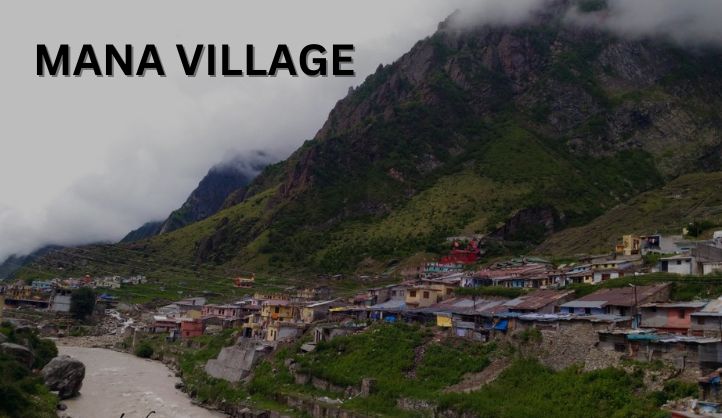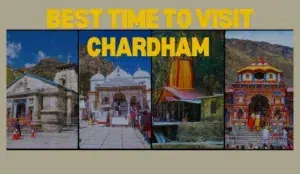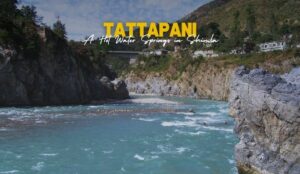Nestled in the majestic Himalayas, Mana Village in Uttarakhand stands as the last inhabited village on the Indian border, right next to Tibet. Have you ever wondered what it feels like to be at the edge of civilization, where the road ends and the mountains begin? Mana offers a unique blend of stunning natural beauty, rich cultural heritage, and a touch of mystical allure. This article explores the various facets of Mana Village, offering insights into its history, culture, and attractions.
Historical Background
Mana Village is not just a geographical landmark; it’s a place rich in history and mythology. The village is believed to have been named after the Manas, an ancient tribe that once inhabited the region. However, the most captivating aspect of Mana’s history lies in its connections to Hindu mythology.
The Pandavas’ Journey to Heaven
According to the Mahabharata, the Pandavas passed through Mana Village on their way to Swargarohini, the mythical staircase to heaven. This journey, known as the Mahaprasthanika Parva, is said to have been their final ascent to attain salvation. Various sites in and around Mana, such as the Bhim Pul and the Vyas Gufa, are linked to this epic tale.
The Legend of Vyasa and Ganesha
Another fascinating legend associated with Mana Village is that of Sage Vyasa, who is believed to have dictated the Mahabharata to Lord Ganesha at Vyas Gufa. This cave is a significant pilgrimage site for devotees and history enthusiasts alike.
Geographical Significance: The Gateway to Tibet
Situated at an altitude of approximately 3,200 meters (10,500 feet), Mana Village is the last Indian village before the Tibet border. The village is located just 3 kilometers from the famous Badrinath Temple, one of the holiest shrines in Hinduism.
The Mana Pass
Mana Pass, also known as Mana La, is a high-altitude pass that connects India with Tibet. It is one of the highest motorable passes in the world, offering breathtaking views of the surrounding peaks and valleys. The pass is strategically important and has been used as a trade route since ancient times.
Climate and Environment
The climate in Mana Village is harsh, with cold winters and short, cool summers. The area is known for its rugged terrain, alpine meadows, and glacial streams. The village is surrounded by towering peaks, including Nilkantha and Kamet, which add to its scenic beauty.
Cultural and Traditional Heritage
Mana Village is home to the Bhotiya tribe, an indigenous community with a rich cultural heritage. The Bhotiyas are of Tibetan origin and have a unique lifestyle and traditions.
Traditional Attire
The people of Mana Village wear traditional Bhotiya attire, which includes woolen garments to protect them from the cold. The men wear a woolen cap called “Zera” and a tunic known as “Bakhu,” while the women wear colorful skirts and shawls.
Language and Festivals
The primary language spoken in Mana is Bhoti, a Tibeto-Burman language. The villagers celebrate various festivals, including Nanda Devi Raj Jat Yatra and Janmashtami, with great fervor. The festivals are marked by traditional music, dance, and rituals.
The Legendary Saraswati River
One of the most intriguing features of Mana Village is the Saraswati River, considered sacred in Hindu mythology. The river originates from the Saraswati Glacier near Mana and flows through the village before merging with the Alaknanda River at Keshav Prayag.
The Mythical Disappearance
According to legend, the Saraswati River disappeared underground due to a curse by Sage Durvasa. It is believed that the river still flows beneath the ground, and its waters have purifying properties. The Saraswati River is often referred to as the “invisible river” in Hindu scriptures.
Key Attractions in Mana Village
Mana Village offers a range of attractions that appeal to both spiritual seekers and adventure enthusiasts. Here are some of the must-visit sites:
Vyas Gufa – The Sage’s Abode
Vyas Gufa, or Vyasa’s Cave, is believed to be the place where Sage Vyasa composed the Mahabharata with the help of Lord Ganesha. The cave is adorned with images and idols of Vyasa and Ganesha, and it offers a peaceful environment for meditation and reflection.
Bhim Pul – A Bridge of Legends
Bhim Pul is a natural rock bridge over the Saraswati River, said to have been created by Bhima, one of the Pandavas. According to legend, Bhima placed a huge rock across the river to help Draupadi cross it. The site offers stunning views of the river and the surrounding landscape.
Ganesh Gufa – A Writer’s Haven
Ganesh Gufa is another cave associated with the legend of Vyasa and Ganesha. It is believed that Lord Ganesha resided in this cave while writing down the Mahabharata. The cave is smaller than Vyas Gufa but equally significant in its cultural and historical context.
The People of Mana – A Glimpse into Local Life
The people of Mana Village lead a simple yet culturally rich life. Their traditions and lifestyle are deeply influenced by their Tibetan roots and the harsh environment in which they live.
Livelihood and Economy
The primary occupation of the villagers is agriculture, with crops like potatoes, barley, and buckwheat being the main produce. The villagers also engage in weaving and handicrafts, creating beautiful woolen shawls, carpets, and traditional garments. In recent years, tourism has become an important source of income for the village.
Hospitality and Cuisine
The people of Mana are known for their warm hospitality. Visitors are often welcomed with traditional Bhotiya tea, made from yak milk and butter. The local cuisine includes dishes like “Kheema” (minced meat) and “Sattu” (roasted gram flour), which are both nutritious and suited to the cold climate.
Trekking and Adventure Activities
Mana Village is a haven for trekking and adventure enthusiasts. The village serves as a base for several trekking routes, including the trek to Vasudhara Falls and the Mana Pass.
Vasudhara Falls
Vasudhara Falls is a spectacular waterfall located about 6 kilometers from Mana Village. The trek to the falls offers breathtaking views of the surrounding mountains and valleys. It is believed that the water of the falls has healing properties.
Trek to Mana Pass
For the more adventurous, the trek to Mana Pass offers a challenging yet rewarding experience. The trek takes you through rugged terrain, alpine meadows, and glacial streams, culminating in panoramic views of the Himalayas. The pass is open for trekking during the summer months, from May to October.
Practical Information for Visitors
Planning a trip to Mana Village requires some preparation, especially given its remote location and high altitude.
How to Reach
Mana Village is located about 4 kilometers from Badrinath, the nearest major town. The village is accessible by road, with regular bus and taxi services available from Badrinath. The nearest railway station is in Rishikesh, about 300 kilometers away, and the nearest airport is in Dehradun, about 320 kilometers from Mana.
Stays and Amenities
While there are no luxury hotels in Mana Village, there are several guesthouses and lodges that offer basic amenities. Staying in a local guesthouse provides an opportunity to experience the traditional Bhotiya lifestyle. It is advisable to book accommodation in advance, especially during the peak tourist season.
Best Time to Visit
The best time to visit Mana Village is from May to October when the weather is relatively mild and the trekking routes are open. The village remains closed during the winter months due to heavy snowfall and harsh weather conditions.
The Char Dham Yatra and Mana Village
Mana village serves as a vital stopover for pilgrims on the Char Dham Yatra, a sacred pilgrimage circuit that includes the temples of Badrinath, Kedarnath, Gangotri, and Yamunotri. The village’s proximity to Badrinath, one of the Char Dhams, makes it an essential part of the journey. Pilgrims often visit the Badrinath Temple to seek blessings and marvel at the stunning architecture and serene surroundings.
Personal Experiences and Anecdotes
Visiting Mana Village is not just about the scenic beauty and historical sites; it’s also about the experiences and stories you gather along the way.
A Traveler’s Reflection
One traveler shared, “Mana Village is a place that makes you reflect on the simplicity and beauty of life. The villagers live a life that is in harmony with nature, and their stories and traditions are fascinating. The trek to Vasudhara Falls was challenging but worth every step for the breathtaking views.”
The Warmth of the Locals
Another visitor noted, “The people of Mana are incredibly welcoming and hospitable. I was invited into a local family’s home, where they shared stories about their customs and traditions. It was a humbling experience that gave me a deeper appreciation for their way of life.”
Thrilling River Rafting Adventures
For adventure enthusiasts, Mana Village offers more than just spiritual experiences. The village is located near the Alaknanda River, a tributary of the Ganges, which provides excellent opportunities for river rafting. The turbulent waters of the Alaknanda make for an exhilarating rafting experience, with varying levels of rapids that cater to both beginners and seasoned rafters. The combination of breathtaking landscapes and adrenaline-pumping rapids makes river rafting in this region an unforgettable adventure.
Other Villages of Uttarakhand
Uttarakhand, known as the “Land of the Gods,” is home to numerous picturesque villages, each offering unique cultural experiences, natural beauty, and historical significance. Here are a few notable villages in Uttarakhand:
1. Ghangaria
Ghangaria is a small village situated on the way to the Valley of Flowers and Hemkund Sahib. It serves as the base camp for trekkers and pilgrims visiting these renowned sites. The village offers stunning views of the surrounding peaks and lush greenery, making it a popular destination for nature lovers and adventure enthusiasts.
2. Munsiyari
Located in the Pithoragarh district, Munsiyari is a charming village known for its panoramic views of the Himalayan range, including the majestic Panchachuli peaks. It’s a haven for trekkers, with trails leading to the Milam and Ralam glaciers. The village is also rich in local culture, offering insights into the traditions of the Bhotia community.
3. Khirsu
Khirsu, located in the Pauri Garhwal district, is a peaceful village surrounded by dense forests and orchards. It offers a tranquil retreat from the hustle and bustle of city life. The village provides breathtaking views of the snow-capped Himalayan peaks and is an ideal destination for nature walks and bird watching.
4. Chopta
Chopta, often referred to as the “Mini Switzerland of India,” is a picturesque village located in the Rudraprayag district. It serves as the starting point for treks to Tungnath, the highest Shiva temple in the world, and Chandrashila peak. Chopta is known for its lush meadows, dense forests, and stunning mountain views.
5. Kausani
Kausani is a serene hill station and village in the Bageshwar district, famous for its panoramic views of the Himalayan peaks, including Nanda Devi, Trishul, and Panchachuli. The village is known for its tea gardens, lush landscapes, and as the birthplace of the renowned poet Sumitranandan Pant. Kausani is a perfect destination for those seeking solitude and natural beauty.
6. Lohaghat
Situated in the Champawat district, Lohaghat is a historical village with a rich cultural heritage. It is known for the ancient temples of Abbot Mount and the Mayawati Ashram, a spiritual center established by Swami Vivekananda. The village is surrounded by picturesque landscapes and offers a peaceful atmosphere for visitors.
7. Landour
Landour is a quaint village located near Mussoorie, known for its colonial charm and serene environment. It is home to historic churches, the iconic Char Dukan (four shops), and scenic walking trails. Landour offers stunning views of the Doon Valley and is a popular destination for writers and artists seeking inspiration.
8. Kanatal
Kanatal is a small village located in the Tehri Garhwal district, known for its tranquil environment and stunning views of the Himalayas. It is a popular destination for camping, trekking, and nature walks. The village is surrounded by dense forests and offers a peaceful retreat for travelers looking to unwind in nature.
Each of these villages offers a unique experience, from spiritual journeys and historical exploration to adventure and natural beauty. Visiting these villages provides an opportunity to explore the rich cultural heritage and diverse landscapes of Uttarakhand.
Conclusion
Mana Village is more than just a tourist destination; it’s a place that offers a unique blend of natural beauty, cultural richness, and spiritual significance whether you’re drawn by the village’s historical and mythological connections, its stunning landscapes, or the warmth of its people, Mana provides an experience that stays with you long after you’ve left. It is a journey to the edge of civilization, where the roads end and the mysteries of the Himalayas begin. As you stand on the brink, looking out towards the distant peaks, you’re reminded of the stories and legends that make this place so special.
For those seeking adventure, spirituality, or simply a moment of peace away from the bustling world, Mana Village is an ideal destination. It encourages visitors to pause, reflect, and connect with a simpler way of life. The village’s charm lies not just in its picturesque setting but in its ability to transport you to a time and place where myths and reality blend seamlessly.
FAQs About Mana Village in Uttarakhand
1. How can I reach Mana Village?
Mana Village is accessible by road from Badrinath, which is approximately 4 kilometers away. The nearest major railway station is in Rishikesh, around 300 kilometers from Mana, and the closest airport is in Dehradun, about 320 kilometers away. Regular bus and taxi services connect Badrinath with Mana.
2. What is the best time to visit Mana Village?
The best time to visit Mana Village is between May and October, during which the weather is mild, and trekking routes are accessible. The village is closed in winter due to heavy snowfall and harsh conditions.
3. What are the key attractions in Mana Village?
Mana Village offers several attractions, including Vyas Gufa, Bhim Pul, Ganesh Gufa, and the Saraswati River. The village also serves as a base for treks to Vasudhara Falls and Mana Pass.
4. What kind of accommodation is available in Mana Village?
Accommodation options in Mana Village are limited to guesthouses and lodges that provide basic amenities. These lodgings offer an authentic experience of local Bhotiya culture.
5. Is Mana Village safe for solo travelers?
Yes, Mana Village is considered safe for solo travelers. The locals are friendly and welcoming. However, due to its remote location and high altitude, it’s advisable to be well-prepared and informed about the local weather and terrain.
6. What kind of food is available in Mana Village?
The local cuisine includes traditional Bhotiya dishes like “Kheema” (minced meat) and “Sattu” (roasted gram flour). Visitors can also enjoy a unique Bhotiya tea made from yak milk and butter.





